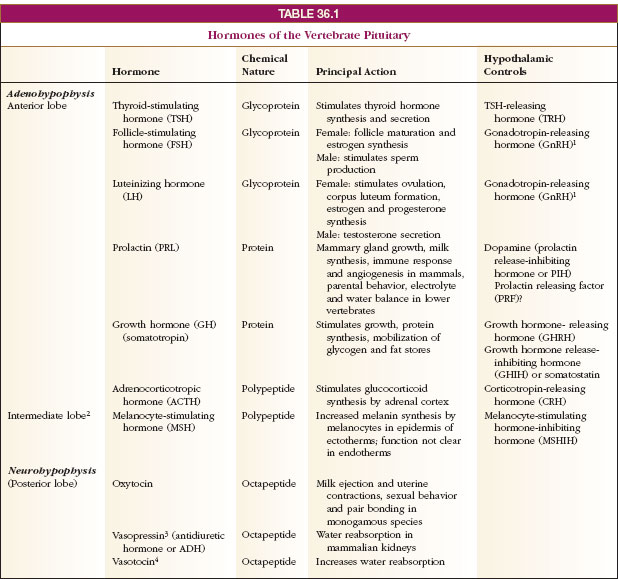Posterior Pituitary
Posterior Pituitary
The hypothalamus is the source of two hormones of the posterior lobe of the pituitary (Table 36-1). They are formed in neurosecretory cells in the hypothalamus, whose axons extend down the infundibular stalk and into the posterior lobe. The hormones are secreted from axon terminals ending in close proximity to blood capillaries, which the hormones enter when released (see Figure 36-5). In a sense the posterior lobe is not a true endocrine gland, but a storage and release center for hormones manufactured entirely in the hypothalamus. The two posterior lobe hormones of mammals, oxytocin and vasopressin, are chemically very much alike. Both are polypeptides consisting of eight amino acids and are called octapeptides (Figure 36-7). These hormones are among the fastest-acting hormones, since they are capable of producing a response within seconds of their release from the posterior lobe.
Oxytocin has two important specialized reproductive functions in adult female mammals. It stimulates contraction of uterine smooth muscles during parturition (birth of the young). In clinical practice, oxytocin is used to induce delivery during a difficult labor and to prevent uterine hemorrhage after birth. A second action of oxytocin is that of milk ejection by the mammary glands in response to suckling. Recent work also has established a role for oxytocin in pair-bonding behavior in both sexes in monogamous voles.
Vasopressin, the second posterior lobe hormone, acts on collecting ducts of the kidney to increase water reabsorption and thus restrict urine flow, as already described on. It is therefore often called antidiuretic hormone. Vasopressin also increases blood pressure through its generalized constrictor effect on smooth muscles of arterioles. Finally, vasopressin acts centrally to increase thirst, and therefore, drinking behavior.
All jawed vertebrates secrete two posterior lobe hormones that are quite similar to those of mammals. All are octapeptides, but their structures vary because of amino acid substitutions in three of eight amino acid positions in the molecule.
Of all posterior lobe hormones, vasotocin (Table 36-1) has the widest phylogenetic distribution and is believed to be the parent hormone from which other octapeptides evolved. It is found in all vertebrate classes except mammals. It is a water-balance hormone in amphibians, especially toads, in which it acts to conserve water by (1) increasing permeability of skin (to promote water absorption from the environment), (2) stimulating water reabsorption from the urinary bladder, and (3) decreasing urine flow. Action of vasotocin is best understood in amphibians, but it appears to play some water-conserving role in birds and reptiles as well.
The hypothalamus is the source of two hormones of the posterior lobe of the pituitary (Table 36-1). They are formed in neurosecretory cells in the hypothalamus, whose axons extend down the infundibular stalk and into the posterior lobe. The hormones are secreted from axon terminals ending in close proximity to blood capillaries, which the hormones enter when released (see Figure 36-5). In a sense the posterior lobe is not a true endocrine gland, but a storage and release center for hormones manufactured entirely in the hypothalamus. The two posterior lobe hormones of mammals, oxytocin and vasopressin, are chemically very much alike. Both are polypeptides consisting of eight amino acids and are called octapeptides (Figure 36-7). These hormones are among the fastest-acting hormones, since they are capable of producing a response within seconds of their release from the posterior lobe.
 |
| Figure 36-7 Posterior lobe hormones of mammals. Both oxytocin and vasopress in consist of eight amino acids (the two sulfur-linked cysteine molecules are considered a single amino acid, cystine). Oxytocin and vasopressin are identical except for amino acid substitutions in the blue positions. Abbreviations represent amino acids. |
Oxytocin has two important specialized reproductive functions in adult female mammals. It stimulates contraction of uterine smooth muscles during parturition (birth of the young). In clinical practice, oxytocin is used to induce delivery during a difficult labor and to prevent uterine hemorrhage after birth. A second action of oxytocin is that of milk ejection by the mammary glands in response to suckling. Recent work also has established a role for oxytocin in pair-bonding behavior in both sexes in monogamous voles.
Vasopressin, the second posterior lobe hormone, acts on collecting ducts of the kidney to increase water reabsorption and thus restrict urine flow, as already described on. It is therefore often called antidiuretic hormone. Vasopressin also increases blood pressure through its generalized constrictor effect on smooth muscles of arterioles. Finally, vasopressin acts centrally to increase thirst, and therefore, drinking behavior.
All jawed vertebrates secrete two posterior lobe hormones that are quite similar to those of mammals. All are octapeptides, but their structures vary because of amino acid substitutions in three of eight amino acid positions in the molecule.
 |
|
|
Of all posterior lobe hormones, vasotocin (Table 36-1) has the widest phylogenetic distribution and is believed to be the parent hormone from which other octapeptides evolved. It is found in all vertebrate classes except mammals. It is a water-balance hormone in amphibians, especially toads, in which it acts to conserve water by (1) increasing permeability of skin (to promote water absorption from the environment), (2) stimulating water reabsorption from the urinary bladder, and (3) decreasing urine flow. Action of vasotocin is best understood in amphibians, but it appears to play some water-conserving role in birds and reptiles as well.




